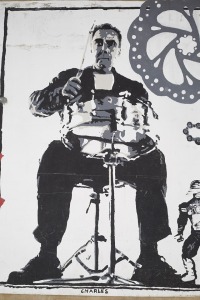Retrophonica is a new, very accessible multi-media performance project; currently focussed on the branching aerials, primal wooo and touch-me-not anticipations of theremin playing. It’s launching itself with an evening of two (identical) concerts in the yawning brick gullet of the Brunel Museum’s Grand Entrance Chamber (also known as the top of the southern Thames Tunnel shaft).
Celebrating the instrument’s centenary, these will be an “immersive evening of music for theremin and full orchestra”, while delving into the story of the instrument’s creator, Léon Theremin. From here, it sounds as if the concerts will be a cross between a pops-orchestra occasion, a slide-show history lesson writ large and a session of nostalgic avant-garde tinkering; all of it enclosed in that bleak, beautiful and magnificently functional Victorian civil-engineering maw.
As they say themselves,“prepare for an immersive audio-visual experience, complemented by cocktails, lightshow, and narration, featuring original and adapted music for theremin by Dmitri Shostakovich, Bohuslav Martinů, Miklós Rózsa, Les Baxter, Claude Debussy and John Williams, performed by Retrophonica with thereminist Charlie Draper, new arrangements and works by Alex Palmer, and bespoke narration from author Ken Hollings.”
You might already know Charlie from all manner of bookings, everywhere, for both theremin and ondes martenot: here’s an earlier mention. Alex has written and arranged extensively for theatre, film and concert hall, and looks as if he’ll be adding the sweeter edge to the evening. As for Ken, although I suspect that he’ll be operating on calmer terms tonight, he’s most likely to be the one to toss in a wild card or two. Having started work in the 1970s as a literary factual editor (how ominous such a description sounds now) he went on to an early-’80s spell as vocalist and cut-up’er in Manchester post-punk band Biting Tongues, followed by an expansion into essays, libretti and experimental fiction (all of which have dipped into and across other disciplines from Japanese films to twentieth-and-twenty-first century politics to data structures).
I’ve no idea who’s contributed the orchestra. As for the cocktails, there’s no further word on them; nor on how you might mix one called a Thames Tunnel.
* * * * * * * *
Just under a week later, downriver at Deptford, London art-rock/post-punk/improvisation godfather Charles Hayward will be putting together the second of this year’s “genre-fluid” Charles Hayward Presents concerts at the Albany, unfurling “new sounds from the underground and outsider scenes of London and beyond” and massing together elements of jazz/improv, art punk, noise, contemporary classical and electronic music.
 According to Charles himself, his own performance centrepiece will be the project-cum-band “Timestretch Alarmsong… a sequence of tunes and sound snakes that I’ve put together with Tom Challenger (Dice Factory/Ma saxophonist), Yoni Silver (multi-instrumentalist with Hyperion Ensemble and many others), Roberto Sassi (Cardosanto/Anatrofobia/Snorkel guitarist), Nick Doyne-Ditmas (double bassist and Hayward collaborator in Monkey Puzzle Trio).
According to Charles himself, his own performance centrepiece will be the project-cum-band “Timestretch Alarmsong… a sequence of tunes and sound snakes that I’ve put together with Tom Challenger (Dice Factory/Ma saxophonist), Yoni Silver (multi-instrumentalist with Hyperion Ensemble and many others), Roberto Sassi (Cardosanto/Anatrofobia/Snorkel guitarist), Nick Doyne-Ditmas (double bassist and Hayward collaborator in Monkey Puzzle Trio).
“It’s tightly rehearsed and goes through a wide range of attitudes and (more importantly) emotional energies. To my ears it’s super exciting and I feel like we’ve pushed at a few barriers and come up with something new that has melody, shape and grooves from light to super heavy/dark. There’s no clips available but we will be recording the project for future release. All the players are fantastic musicians and working on the project has been a study in joyful cooperation.”
In the absence of a collective clip, here’s a scatter of solo ones and examples of related projects:
Three other acts join in for the night. ‘Gentle Persuaders’, the latest album from contemporary drum/noise/saxophone ritualists Sly & The Family Drone – is intended as “the politest of bludgeonings”; its creators still merge Ayler-esque free jazz, industrial rock pummel, celebratory machine hiss and the loose-hanging exploratory feel of a bass-less duo. They also still give out drums at their concerts, inviting a congregation of noise.
Also back in the fray is V Ä L V Ē, with music that’s less workshop than workshed. Strongly DIY (featuring reed instruments, electronics, invented gizmos, bass guitar, concert harp and singing women), it’s the sound of a trio of highly trained musical minds phasing back into spontaneity and play. A sort of three-way attempt to become idiot savants via assorted glitchery and boink, semi-spontaneous nursery rhymes and tunelets and musical devices (built out of shelves, tobacco tins, old house bells and similar Branestawmery), but via a female pattern.
Finally, there’s Atatat – a solo project from Liverpool art-freak music mainstay J.C. Barbara (best known as drummer/ranter for aPAtT and Barberos, and here using a very Haywardian array of drums, contact mics, loops and vocals).
Designer Raimund Wong (whose work has adorned posters and releases by Total Refreshment Centre, Church Of Sound and Baba Yaga’s Hut, and who shares Charles’ interest in chance theory and the ingenuity forced on artists via DIY minimalism) will be DJ-ing.
* * * * * * * *
Dates:
Retrophonica
Brunel Museum, Railway Avenue, Rotherhithe, London, SE16 4LF, England
Sunday 13th October 2019, 6.00pm & 8:30pm – information here, here and here
Charles Hayward Presents… (featuring Sly & The Family Drone + VÄLVĒ + Timestretch Alarmsong + Atatat + DJ Raimund Wong)
The Albany, Douglas Way, Deptford, SE8 4AG London, United Kingdom
Saturday, 19 October 2019, 7.30pm – information here and here








